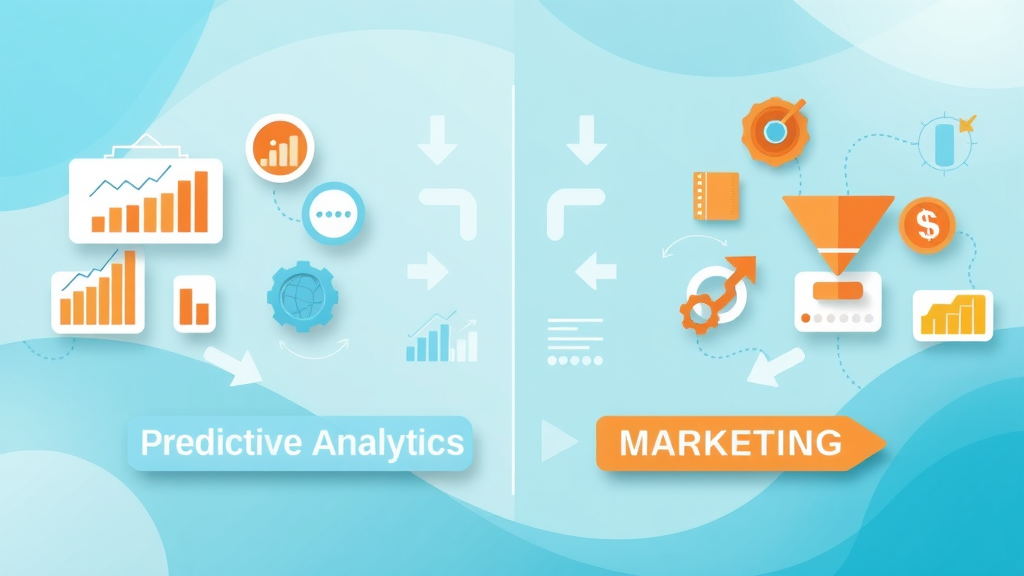Did you know that 86% of marketing leaders who use predictive analytics marketing report improved ROI? With businesses drowning in customer data, only those who leverage predictive models and machine learning will consistently make informed decisions, increase conversion rates, and deliver exceptional customer experience. The days of guessing are over—now’s the time to predict your next win. Read on to see how you can transform your marketing strategy with the power of predictive analytics.
What You'll Learn
- How predictive analytics marketing transforms business outcomes
- Real-world examples that illustrate the power of predictive analytics
- The role of machine learning and data analytics in predictive marketing campaigns
- Actionable steps to implement predictive analytics tools
- How to improve conversion rates, customer segmentation, and marketing strategies
Why Predictive Analytics Marketing is Changing the Game: Shocking Stats and Industry Trends
Predictive analytics marketing is rapidly reshaping the playing field for brands across every industry. Businesses leveraging analytics tools and data science are seeing game-changing improvements in their marketing campaigns. For example, recent studies show companies using predictive marketing strategies experience up to 20% higher conversion rates and a 15% boost in customer retention. These impressive figures highlight the power of accurate forecasting, targeted customer segmentation, and automation fueled by machine learning.
Unprecedented access to big data and advances in artificial intelligence have made it easier for marketing teams to accurately predict customer behaviors and future outcomes. Social media channels, email marketing, and direct-to-consumer campaigns now generate more data points than ever—providing a goldmine for predictive models. With analytics software evolving at breakneck speed, even small businesses can reap the benefits once reserved for enterprise giants. Industry trends make it clear: If you aren’t using predictive analytics in your marketing efforts, you risk being left behind.

Unlocking Success with Predictive Analytics in Marketing: Key Takeaways
- Business Transformation: Predictive analytics marketing delivers actionable insights that dramatically improve marketing ROI.
- Real-World Power: Major brands use predictive models to fine-tune marketing strategies and anticipate customer needs.
- Machine Learning Integration: Machine learning is central to automated marketing analytics, helping teams better understand customer segments.
- Practical Tools: Adopting modern analytics tools is key for maximizing future outcomes and refining marketing campaigns.
- Conversion Optimization: Targeted messaging and smart automation result in noticeable increases in conversion rates and overall marketing impact.
Defining Predictive Analytics Marketing: Foundations Every Marketer Needs
At its core, predictive analytics marketing is about using advanced data analytics and machine learning to anticipate customer behaviors, optimize marketing efforts, and make informed decisions. Unlike traditional analytics tools that offer a rearview mirror look at what happened, predictive marketing looks forward, empowering brands to take actionable steps before trends emerge. This forward-thinking approach gives marketing teams a competitive edge, enabling them to efficiently allocate budgets, personalize campaigns, and adapt to rapidly changing consumer preferences.
The foundations of predictive analytics marketing require a clear understanding of customer data , data analytics, and the inner workings of predictive models. Marketers must learn to blend historical data, real-time metrics, and artificial intelligence to forecast outcomes with remarkable accuracy. By mastering these fundamentals, you’ll not only enhance your current marketing strategies but also build a future-proof foundation for continued success.
Predictive Analytics vs. Predictive Marketing: What’s the Difference?
While the terms are often used interchangeably, there’s a distinct difference between predictive analytics and predictive marketing . Predictive analytics refers to the broad process of analyzing historical data and current data points to predict future outcomes across various business functions. It’s utilized in finance, healthcare, retail, and beyond. Predictive marketing, on the other hand, is the application of these analytics principles specifically to marketing strategies and campaigns, aimed at boosting conversion rates, enhancing customer experience, and optimizing marketing spend.
In short, predictive analytics is the science; predictive marketing is the art of applying that science to the world of marketing. Marketing teams use these approaches to identify hot leads, personalize messaging, and create marketing campaigns tailored to specific customer segments. The integration of analytics tools and machine learning transforms raw data into powerful, actionable insights unique to each brand’s goals.

How Predictive Analytics Marketing Works: From Data to Decisions
The magic of predictive analytics marketing starts with gathering and cleaning customer data from various digital touchpoints—think website visits, social media engagement, purchase history, and more. Data analytics tools then process this information, identifying patterns and correlations that would be impossible for humans to spot unaided. With advanced machine learning algorithms, these platforms build predictive models that accurately predict customer behaviors, such as likelihood to purchase or churn.
Once the models deliver their forecasts, marketers receive targeted recommendations for optimizing their marketing campaigns. This might involve adjusting email sends, crafting audience-specific ads, or revising segmentation strategies. The cycle is continuous—data-driven insights lead to new marketing efforts, more results are collected, and the model becomes even more accurate over time. The ongoing refinement makes predictive marketing a dynamic process that keeps brands ahead in the marketplace.
Key Terms: Predictive Analytics, Analytics Tool, and Machine Learning Demystified
Understanding key terms is essential for mastering predictive analytics marketing:
- Predictive Analytics: The use of algorithms and data science to analyze current and historical data, identifying patterns that help accurately predict future outcomes .
- Analytics Tool: Software that collects, processes, and visualizes data to assist marketers in uncovering actionable insights.
- Machine Learning: A form of artificial intelligence where computer systems automatically learn and improve from experience, adapting predictive models to reflect changes in customer behavior and marketing trends.
The synergy between these concepts enables business owners and marketing teams to transform data points into strategies that work in the real world.
What is Predictive Analytics in Marketing?
Predictive analytics in marketing refers to the application of data analytics, machine learning, and statistical techniques to forecast customer behaviors, optimize customer segmentation, and inform marketing strategies. Rather than relying on hunches, predictive analytics harnesses vast amounts of customer data and social media signals to inform every step of a marketing campaign—from lead generation and nurture to final conversion.
Marketers often use predictive models to score leads, determine optimal send times for messages, and even anticipate which products a customer segment is most likely to buy next. This helps marketing teams tailor their efforts, improving conversion rates while reducing wasted spend. By bringing together analytics tools, historical data, and real-time insights, predictive analytics marketing positions brands to win in fiercely competitive markets.
Explaining the Core Principles of Predictive Analytics Marketing
The foundation of predictive analytics marketing rests on leveraging data science and artificial intelligence to forecast trends and consumer actions. The process begins by collecting robust, relevant customer data from numerous touchpoints—online purchases, browsing behavior, and even responses to previous marketing campaigns. Machine learning algorithms then sift through these massive datasets, identifying trends and patterns that human marketers may miss.
The result is a predictive model that continually adapts to new insights. Whether it’s anticipating customer churn, optimizing messaging frequency, or defining precise marketing strategies for specific customer segments, predictive analytics marketing gives teams the ability to act quickly and effectively. By relying on data analytics rather than gut instinct, marketing efforts become both more cost-effective and impactful, driving improved conversion rates and enhanced customer experiences.
Benefits of Predictive Analytics for Marketers
Marketers benefit from predictive analytics marketing in several clear and measurable ways. First, predictive models enable business leaders to make informed decisions regarding marketing spend, creative direction, and audience selection. Enhanced customer segmentation and smarter targeting typically translate to higher conversion rates, greater brand loyalty, and more efficient campaigns. Second, the automation built into modern analytics tools streamlines workflows, reducing manual effort while boosting scalability and reach.
Perhaps most importantly, predictive analytics fosters a cycle of continual improvement. Every campaign generates fresh data points, which further refine predictive models and improve future performance. This virtuous feedback loop helps successful marketing teams stay ahead of industry trends—constantly adapting to meet evolving consumer preferences and competitive pressures.

Key Analytics Tools in Predictive Marketing
With the surge in demand for data-driven marketing, a growing number of analytics tools now support predictive marketing campaigns. The most popular include:
- Salesforce Einstein
- IBM Watson Analytics
- HubSpot Marketing Analytics
- SAS Advanced Analytics
These solutions combine powerful data analytics capabilities, machine learning, and user-friendly interfaces to make predictive marketing accessible—even for teams lacking deep data science expertise. Selecting the right analytics tool often comes down to business size, industry, and the complexity of marketing campaigns.
| Tool Name | Core Features | Use Cases | Industry Adoption |
|---|---|---|---|
| Salesforce Einstein | AI-driven insights, CRM integration | Personalization | Widespread |
| IBM Watson Analytics | Natural language processing | Prediction modeling | Enterprise |
| HubSpot Marketing Analytics | Multi-touch attribution | Lead scoring | SMBs |
| SAS Advanced Analytics | Big data, machine learning | Behavior analysis | Global |
Predictive Analytics Marketing in Action: Real-World Case Studies and Use Cases
Nothing brings predictive analytics marketing to life like real-world examples. Famous brands and digital-first disruptors alike are leveraging data analytics and machine learning to maximize their marketing impact. From customer retention to powerful recommendation engines, predictive models are central to today’s most effective marketing campaigns.
For instance, a retail giant uses predictive marketing to determine when customers are most likely to repurchase, resulting in highly-timed email campaigns that yield impressive conversion rates. Even B2B leaders are utilizing analytics software to forecast pipeline growth, qualifying leads more efficiently, and enabling personalized content tailored to each customer segment.
Examples of Predictive Analytics Transforming Digital Marketing Campaigns
Some of the best-known success stories in predictive analytics marketing come from ecommerce. Online retailers combine customer data, historical purchasing patterns, and web activity to recommend products customers didn’t even know they needed. Media companies use predictive models to determine which content will trend next, enabling business growth and audience retention. Sports brands leverage analytics tools to optimize influencer marketing campaigns and social media outreach, ensuring they connect with the most engaged audiences.
For marketing teams, these examples underline the transformative impact predictive analytics can have on marketing strategies. By applying data analytics to every aspect of campaign development and execution, brands move from reactive to proactive marketing—positioning themselves to outperform the competition at every turn.
How Major Brands Use Predictive Analytics to Enhance Customer Experience
Major brands like Amazon, Netflix, and Starbucks have pioneered the use of predictive analytics marketing to drive exceptional customer experiences. Amazon’s recommendation engine, powered by sophisticated machine learning models, drives nearly 35% of total sales by suggesting relevant products based on user behavior and purchase history. Netflix uses predictive analytics to recommend shows tailored to your unique tastes, increasing engagement and reducing churn rates. These giants demonstrate that customer data, when harnessed effectively with analytics tools, is a powerful engine for deeper customer engagement and loyalty.
"Data is the new oil. Predictive analytics marketing turns raw data into actionable fuel for success."

The Science Behind Predictive Analytics Marketing: Data Analytics and Machine Learning
Predictive analytics marketing relies on the robust combination of data analytics and machine learning to transform raw data into actionable intelligence. Data science techniques parse through millions of data points, revealing hidden patterns that enable marketing teams to accurately predict customer behaviors. The science doesn’t stop at predicting purchases—it also powers segmentation, churn reduction, and the creation of highly targeted marketing campaigns.
From collecting structured and unstructured customer data to employing advanced machine learning algorithms, the role of science in predictive marketing is to ensure accuracy and efficiency. Iterative improvement means predictive models are continually refined, delivering even better results with every marketing campaign.
The Role of Data Analytics in Predictive Marketing
Data analytics lies at the heart of every predictive marketing strategy. Marketing teams use analytics tools to aggregate diverse customer data from sources like social media, CRM systems, and e-commerce platforms. Big data analytics enables marketers to spot trends in real time, such as rising interest in specific products or sudden drops in engagement. This empowers timely decision-making that is both strategic and data-driven.
In predictive marketing, data analytics is not just about finding what happened, but about identifying why it happened and what will likely occur next. The best marketing teams seize on these insights to prioritize marketing efforts, refine target audiences, and develop campaigns with higher conversion rates and more compelling customer experiences.
Integrating Machine Learning with Predictive Analytics Marketing
Machine learning supercharges predictive analytics by enabling business software to autonomously learn from historical data, recognize complex patterns, and make increasingly accurate predictions. For marketers, this means analytics tools can automatically refine segments, adjust campaign delivery, and detect new opportunities without manual intervention. Advanced machine learning models even enable real-time personalization, adjusting ads and content to fit each unique visitor’s preferences and behavior.
As predictive analytics marketing matures, more companies are investing in artificial intelligence platforms that combine data analytics and machine learning into a seamless workflow. The result is smarter, more flexible marketing strategies with demonstrably higher ROI.
How Predictive Models Accurately Predict Customer Behaviors
Predictive models leverage a blend of statistical analysis, data science, and artificial intelligence to accurately predict customer behaviors. By ingesting vast quantities of historical data, these models learn which signals correlate with desired outcomes—be it purchases, signups, or repeat business. As customer data grows, these models dynamically adapt, further improving their accuracy over time.
The strongest predictive marketing platforms employ ensemble techniques, combining multiple machine learning algorithms to minimize bias and maximize precision. This multi-layered approach empowers marketers to deploy campaigns that resonate with each customer segment, while also responding rapidly to shifting preferences and marketplace conditions.
Predictive Analytics Marketing Tactics for Every Marketing Campaign
No matter your industry, predictive analytics marketing can dramatically amplify the results of your marketing campaigns. It begins with setting clear objectives—such as improving conversion rates, boosting engagement, or refining customer segmentation—and deploying analytics tools tailored to these goals. With predictive models guiding every phase of execution, marketing teams can anticipate customer needs, personalize journeys, and allocate resources to the highest-value opportunities.
Best-in-class marketers use predictive analytics to test messages, channels, and offers before deploying campaigns at scale. This test-and-learn approach allows for ongoing optimization, ensuring each campaign gets smarter and more effective with time.
Improving Conversion Rate and Conversion Rates Through Predictive Analytics
One of the most immediate and impactful uses of predictive analytics marketing is optimizing conversion rate. Analytics tools identify the most promising leads and pinpoint the optimal channels and touchpoints for engagement. Campaigns informed by predictive models often see double-digit lifts in conversion rates, as every customer receives a message that is relevant to their position in the buying journey.
Predictive models also help marketing teams minimize wasted effort and budget, focusing spend on prospects most likely to convert. Marketers can experiment with different messaging, offers, and creative assets, letting machine learning algorithms determine the highest-performing combinations for each customer segment.

Customer Segmentation: Targeting the Right Customer Segment
Customer segmentation is crucial for delivering effective, relevant campaigns. Predictive analytics marketing enables precise segmentation by analyzing customer data from multiple sources—past purchases, online browsing behaviors, and even social media interactions. By building highly nuanced profiles, marketers can address the specific needs, motivations, and challenges of each customer segment.
This advanced segmentation ensures that each marketing campaign targets the right audience with the right message, driving higher conversion rates and improved customer experience. Marketing teams can create lookalike audiences, prioritize high-value prospects, and orchestrate personalized journeys at scale.
Crafting Data-Driven Marketing Strategies with Predictive Analytics
Truly data-driven marketing strategies start with the insights provided by predictive analytics. By understanding which channels perform best, which messages resonate, and which offers drive action, brands can craft campaigns that deliver measurable impact. Marketing analytics dashboards synthesize these insights, providing marketing teams with a holistic view of campaign performance and next-step recommendations.
The era of marketing by intuition is over. By using analytics software, historical data, and predictive models, today’s marketers can launch, measure, and refine strategies based entirely on real-world data, maximizing both effectiveness and efficiency.
Developing a Winning Predictive Analytics Marketing Strategy
Creating a winning predictive analytics marketing strategy requires both vision and practical execution. Leaders must foster a data-driven culture, investing in the necessary analytics tools and training to deliver results. The blueprint starts with clear objectives, robust models built on quality customer data, and ongoing measurement to ensure predictive marketing initiatives hit their targets.
With customer segmentation, machine learning insights, and continuous optimization, brands can shift from generic campaigns to highly targeted, strategic outreach. The rewards: increased revenue, stronger customer relationships, and marketing teams that move with agility and confidence.
Step-by-Step: How to Launch Your Predictive Marketing Campaign
- Define Your Objectives: Identify what you want to predict—such as conversion rate improvement or customer churn reduction.
- Collect and Prepare Data: Aggregate historical customer data from websites, CRM, social media, and sales records.
- Choose the Right Analytics Tool: Use an analytics tool with robust predictive capabilities and user-friendly dashboards.
- Build and Test Models: Leverage machine learning to create and validate predictive models using your data.
- Apply Insights to Campaigns: Deploy marketing campaigns based on model recommendations and monitor results.
- Measure and Optimize: Continuously refine models and marketing strategies for ever-better results.
Best Practices for Using Predictive Analytics Tools
- Start with clearly defined goals and key performance indicators (KPIs).
- Ensure data quality: Clean, structured, and comprehensive customer data underpins successful predictive marketing.
- Choose flexible, scalable analytics software that integrates with your broader martech stack.
- Foster collaboration between your marketing, data science, and IT teams for optimal model performance.
- Continuously update models to reflect shifting customer behaviors and new market trends.
Measuring Success: Marketing Analytics Metrics that Matter
Success in predictive analytics marketing hinges on tracking performance using key marketing analytics metrics. Focus on:
- Conversion rate and conversion value
- Customer lifetime value (CLV)
- Churn rate and retention
- Engagement rates (opens, clicks, visits)
- ROI on marketing spend
Strong measurement practices help ensure predictive marketing continuously delivers results aligned with business goals.

Segmenting Customers with Predictive Analytics: From Customer Behavior to Campaign Execution
Segmenting customers allows marketing teams to deliver personalized experiences that resonate. Predictive analytics marketing enhances segmentation by analyzing behavioral, transactional, and demographic customer data. The result: campaigns tailored to each customer segment, driving superior engagement, conversion rates, and loyalty.
Moving from generic email blasts to precisely-targeted messaging unlocks more meaningful connections and higher ROI. Predictive segmentation doesn’t just tell you who your customers are—it reveals what drives them, when to reach them, and which offers they’ll find most compelling.
How Customer Segmentation Drives Effective Marketing Campaigns
The secret to powerful marketing campaigns is effective customer segmentation. Predictive analytics uses a combination of historical data, real-time behavioral tracking, and machine learning to divide your audience into actionable groups. Marketing teams can then customize campaigns for each segment, accounting for unique needs and engagement triggers. This precision translates to higher conversion rates, lower acquisition costs, and a dramatically improved customer experience across every channel.
Brands with advanced segmentation capabilities consistently outperform those using one-size-fits-all strategies. Predictive segmentation allows you to focus on the high-value customer segments that fuel growth, while deprioritizing less profitable opportunities.
Personalizing Customer Experience with Predictive Analytics
Predictive analytics marketing is the key to true personalization. By predicting what customers want before they do, brands can serve up offers, content, and experiences uniquely tailored to each user. Whether it’s dynamic product recommendations on an e-commerce site or individualized email journeys, predictive models anticipate needs and deliver the right message at precisely the right moment. The result: more satisfied customers, longer relationships, and stronger lifetime value.
Leading brands show that personalized customer experiences built on predictive analytics generate higher engagement rates, less churn, and measurable increases in customer satisfaction.
Overcoming Challenges in Predictive Analytics Marketing
Despite the many benefits, predictive analytics marketing comes with its share of challenges. Marketers must navigate issues like data privacy, model accuracy, and integration with existing systems. Overcoming these hurdles requires a thoughtful mix of technical expertise, cross-functional collaboration, and an unwavering commitment to ethical data practices.
Following best practices in data collection, stewardship, and algorithm development minimizes risk while unlocking the full potential of predictive marketing strategies. Addressing challenges head on enables brands to reap the rewards of innovation—and maintain customer trust.
Addressing Data Privacy and Ethical Considerations
As customer data becomes central to marketing campaigns, data privacy and ethics rise to the forefront. Brands must comply with regulations such as GDPR and CCPA, ensuring all data analytics activities respect consumer rights. Transparent opt-in processes, robust security protocols, and clear privacy policies are essential for protecting customer information and maintaining loyalty.
Ethical considerations also extend to how predictive models are used—avoiding invasive or manipulative practices and fostering trust. Marketing teams committed to ethical standards ensure their predictive analytics marketing efforts add genuine value for both the brand and the consumer.

Ensuring Data Quality and Accuracy in Predictive Models
Great predictive marketing depends on high-quality, accurate data. Even the strongest machine learning models can fail if they’re built on incomplete or inconsistent customer data. Marketing analytics processes should include steps for regular data cleansing, validation, and enrichment. Integrated analytics tools can automate much of this work, minimizing manual errors and ensuring decisions are always based on reliable information.
Frequent model testing and calibration, combined with ongoing collaboration between marketing and data science teams, helps ensure predictive marketing efforts deliver accurate, actionable insights at every stage.
What are Examples of Predictive Analytics?
Examples of predictive analytics bring the technology to life across both B2C and B2B marketing. In consumer markets, recommendation engines analyze browsing and purchasing patterns to suggest the next best offer, boosting engagement and incremental sales. In B2B, predictive models help spot the companies most likely to convert into customers, using firmographic, behavioral, and intent-based data for lead scoring and account prioritization.
Predictive analytics also forecast demand spikes, optimize pricing strategies, and predict customer churn, enabling business leaders to take informed action before competitors catch up. Every scenario, from content marketing to loyalty program management, stands to gain from the intelligent application of predictive analytics.

Illustrative Scenarios from B2C and B2B Marketing
In B2C, a leading apparel brand uses predictive analytics to identify which styles will trend next season, adjusting inventory and marketing pushes accordingly. For B2B, large technology providers rely on predictive scoring to highlight the prospects most likely to need their solutions.
Social media platforms use predictive models to determine which ads or posts are most likely to engage each user, tailoring feeds and promotions for maximum impact. These scenarios underline how predictive analytics marketing delivers real business outcomes at every market size and vertical.
How Predictive Analytics Forecast Sales and Customer Retention
Predictive analytics forecast sales by analyzing patterns in historical data, seasonality, and external factors like market trends. Models can predict which customers will purchase soon, which are at risk of churning, and what marketing efforts will be most effective for retention.
Businesses use these forecasts to optimize inventory, tailor follow-up communications, and proactively address customer needs—turning prediction into profit through smarter, more adaptive marketing strategies.
What is Predictive Analytics for B2B Marketing?
Predictive analytics for B2B marketing introduces advanced analytics tools and models specifically designed to handle multi-stakeholder sales cycles, longer lead times, and complex customer journeys. The focus is on finding high-value accounts, personalizing outreach, and forecasting pipeline growth with precision.
Machine learning enables B2B marketing teams to sift through large data sets, identify patterns in buying behavior, and accurately predict which accounts are most likely to convert. This data-driven approach streamlines the entire marketing process, saving time and maximizing return on investment.
Unique Considerations for B2B Predictive Marketing
B2B predictive marketing accounts for factors such as account hierarchies, diverse decision makers, and longer purchase cycles. The data used to build predictive models might include engagement with gated content, sales calls, and event attendance in addition to digital activity. These models focus on finding deep signals of intent, helping sales and marketing collaborate more effectively.
B2B marketers gain an edge when integrating predictive analytics with account-based marketing strategies, ensuring resources are allocated to the most promising opportunities at any given moment.
Improving Lead Scoring and Account-Based Marketing with Predictive Analytics
Predictive analytics revolutionizes lead scoring by replacing simplistic rule-based systems with dynamic, adaptive models. These models use diverse data points—from website engagement to email opens and deal progression—to assign scores that reflect real purchase likelihood. Marketers can automate outreach to hot leads while nurturing colder ones, maximizing the efficiency of marketing efforts.
For account-based marketing, predictive analytics helps prioritize high-value accounts, craft highly personalized campaigns, and accurately measure impact. This ensures marketing and sales resources are always directed where they’ll make the most difference for organizational growth.
What is Predictive Research in Marketing?
Predictive research in marketing is an approach focused on controlled data collection and experimentation to uncover causal relationships and forecast outcomes. Unlike broad predictive analytics, which leverages existing big data to generate insights, predictive research often involves hypothesis testing and trial campaigns that provide additional data points for refinement.
When used alongside predictive analytics marketing, predictive research can unlock even deeper insights, revealing not just what is likely to happen but why. The combination of both methods empowers marketing teams to optimize every aspect of campaign development and execution.
Defining Predictive Research and Its Role in Marketing Strategies
Predictive research uses experiments, A/B testing, and scenario modeling to evaluate potential outcomes before full-scale marketing campaigns are launched. This approach enables business leaders to test new messaging, pricing, or creative assets—gathering actionable feedback with minimal risk. Predictive research assists in refining predictive models, ensuring accuracy and relevance for every target customer segment.
Its role in marketing strategies is complementary: while predictive analytics uncovers patterns in existing data, predictive research fills in gaps and explores new frontiers, driving innovation and better results.
Difference Between Predictive Analytics Marketing and Predictive Research
The key difference lies in methodology and scope . Predictive analytics marketing relies heavily on vast amounts of real-world, historical data to forecast outcomes across segments. In contrast, predictive research uses structured tests and experiments, often with smaller, curated data sets, to validate hypotheses and support decision-making for future campaigns.
"Predictive analytics marketing isn’t about fortune-telling. It’s about making informed decisions in real time, benefiting brands and customers alike."
Both approaches are powerful—used together, they provide the clearest roadmap for future marketing success.
Frequently Asked Questions
-
How accurate are predictive marketing models?
Predictive marketing models can be highly accurate, often improving with more high-quality customer data. Their precision depends on data quality, model complexity, and continual testing. Industry experts report uplift in marketing ROI and conversion rates using well-maintained predictive models. -
Do analytics tools require coding expertise?
Many modern analytics tools are user-friendly and require little or no coding expertise. Platforms like Salesforce Einstein and HubSpot offer intuitive interfaces, allowing marketers to use predictive analytics effectively without advanced technical skills. -
Can small businesses benefit from predictive analytics marketing?
Absolutely. Predictive analytics marketing tools are now accessible for small businesses, helping them increase conversion rates, optimize marketing spend, and compete with larger brands by leveraging targeted, data-driven campaigns. -
What industries benefit most from predictive analytics?
Nearly every industry benefits, but retail, e-commerce, financial services, healthcare, and technology are leaders in adopting predictive analytics marketing. Any business with customer data and repeat marketing campaigns stands to gain substantial value.
Get Started with Predictive Analytics Marketing Today
The future of marketing is predictive—embrace it to stay ahead of the curve. By harnessing analytics tools, data analytics, and machine learning, any business can unlock unprecedented growth and ROI.
Practical Steps to Begin Implementing Predictive Marketing
- Assess your current data assets and identify key business objectives for predictive analytics marketing.
- Choose the right analytics software based on your goals, resources, and technical expertise.
- Invest in team training: Stay updated with the latest data science and marketing analytics trends.
- Start with a pilot project; analyze results, iterate, and scale what works.
Resources, Training, and Tools for Marketers
- Certifications: Consider platforms such as Google Analytics, IBM Watson Academy, or HubSpot Inbound Marketing.
- Communities: Join LinkedIn groups focused on predictive analytics and data-driven marketing.
- Ongoing Education: Subscribe to marketing analytics blogs and attend virtual data science conferences to keep skills sharp.
Watch this short explainer video to see how predictive analytics marketing works, key advantages, and real-world use cases streamlined for easy understanding.
See predictive analytics in action and learn how marketing teams use these tools to drastically increase conversion rates with targeted, relevant campaigns.
Discover step-by-step guidance on creating marketing strategies fueled by predictive analytics and real-time data science insights.
Key Facts to Remember about Predictive Analytics Marketing
- Predictive analytics marketing delivers measurable ROI
- Machine learning and data analytics combine to forecast customer behavior
- Customer segmentation is crucial for relevant marketing campaigns
- Analytics tools empower actionable insights to optimize marketing strategies
Conclusion
Start applying predictive analytics marketing now: leverage high-quality data, select the right analytics tools, and foster collaboration to maximize marketing ROI and outpace the competition.
Sources
- https://www.gartner.com/en/insights/analytics
- https://www.salesforce.com/products/einstein/overview/
- https://www.ibm.com/products/watson-analytics
- https://blog.hubspot.com/marketing/predictive-analytics-marketing
- https://www.sas.com/en_us/insights/analytics/predictive-analytics.html
To deepen your understanding of predictive analytics in marketing, consider exploring the following resources:
-
“How to Use Predictive Analytics in Data-Driven Marketing” : This article delves into the role of predictive analytics in enhancing marketing strategies, offering insights into measurement models and practical applications. ( marketingevolution.com )
-
“Predictive Analytics in Marketing: 7 Use Cases” : This piece presents real-world examples of how predictive analytics is applied across various marketing scenarios, illustrating its impact on product development, customer segmentation, and more. ( itransition.com )
These resources provide valuable perspectives on leveraging predictive analytics to optimize marketing efforts and drive business success.
 Add Row
Add Row  Add
Add 




Write A Comment